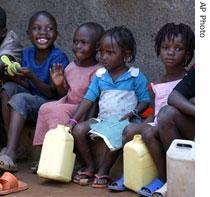VOA慢速英语 2008 1217a
时间:2018-12-01 作者:英语课 分类:VOA慢速英语2008年(十二)月
Every day, more than two thousand children worldwide die from accidental injury. Each year, as many as three million children are saved from one leading cause of child deaths -- drowning. Yet survivors 1 can suffer brain damage. As a result, the lifetime health and economic costs of a non-fatal drowning are the highest on average of any kind of injury.
These are among the findings in the "World Report on Child Injury Prevention." The new report is the first of its kind from the World Health Organization and UNICEF.
Doctor Etienne Krug at the W.H.O. says that every year, eight hundred thirty thousand children die from accidental injuries.
ETIENNE KRUG: "It’s like wiping out every year the whole population of children in Chicago or a city like Marseilles. It’s a very big public health issue, which, unfortunately, has been ignored for too long. The main causes of child unintentional injuries are road traffic crashes, drowning, burns, falls and poisoning."
Poor children everywhere are most at risk. But the report's top editor, Margie Peden, says more than ninety-five percent of child injuries happen in developing nations.

Children in Uganda
MARGIE PEDEN: "Africa, unfortunately, has the highest rate of all these accidental injuries, unintentional injuries. In particular, road traffic injuries, as well as poisoning. One of the reasons for that is because many people in Africa are still dependent on paraffin or kerosene 2 for heating and lighting 3."
The report says Africa's death rate is ten times higher than in wealthier countries in Europe and the Western Pacific. Countries such as Australia, the Netherlands, New Zealand, Sweden and Britain have the lowest rates of child injury. Yet even in high-income countries, accidental injuries still cause forty percent of all child deaths.
The report says at least one thousand young lives could be saved every day if a few simple measures were taken everywhere.
These include requiring children to wear seatbelts in cars and helmets on bikes. Limiting the temperature of hot water systems could prevent burns. And water should not be left standing 4 in baths or buckets where small children could drown. Medicine bottles, lighters 5 and household product containers should have child resistant 6 closures.
Yet the report warns that even a safety measure like airbags in the front seat of a car could harm children under age thirteen. And it advises people not to use traditional home treatments like butter, sugar or oil on burns.
And that's the VOA Special English Health Report, written by Caty Weaver 7 with reporting from Lisa Schlein in Geneva. I’m Barbara Klein.
- The survivors were adrift in a lifeboat for six days. 幸存者在救生艇上漂流了六天。
- survivors clinging to a raft 紧紧抓住救生筏的幸存者
- It is like putting out a fire with kerosene.这就像用煤油灭火。
- Instead of electricity,there were kerosene lanterns.没有电,有煤油灯。
- The gas lamp gradually lost ground to electric lighting.煤气灯逐渐为电灯所代替。
- The lighting in that restaurant is soft and romantic.那个餐馆照明柔和而且浪漫。
- After the earthquake only a few houses were left standing.地震过后只有几幢房屋还立着。
- They're standing out against any change in the law.他们坚决反对对法律做任何修改。
- The cargo is being discharged into lighters. 正在往驳船里卸货。 来自《现代汉英综合大词典》
- Babies'bootees and cheap cigarette lighters were displayed in unlikely juxtaposition. 儿童的短靴和廉价的打火机很不相称地陈列在一起。 来自辞典例句